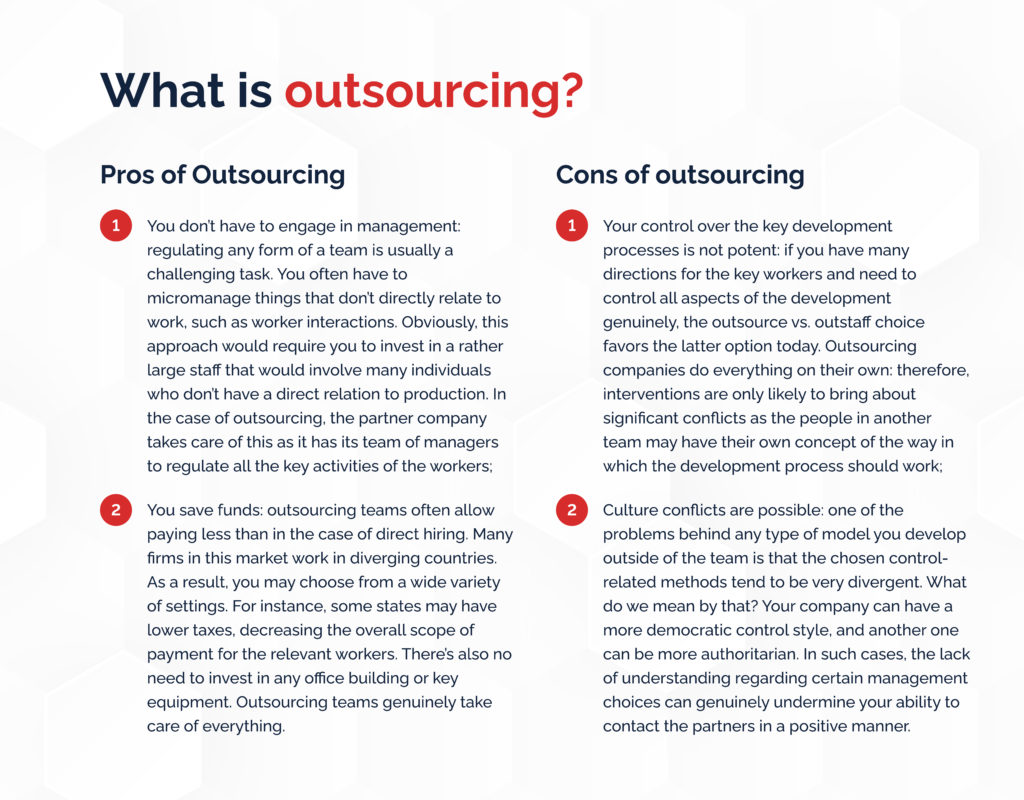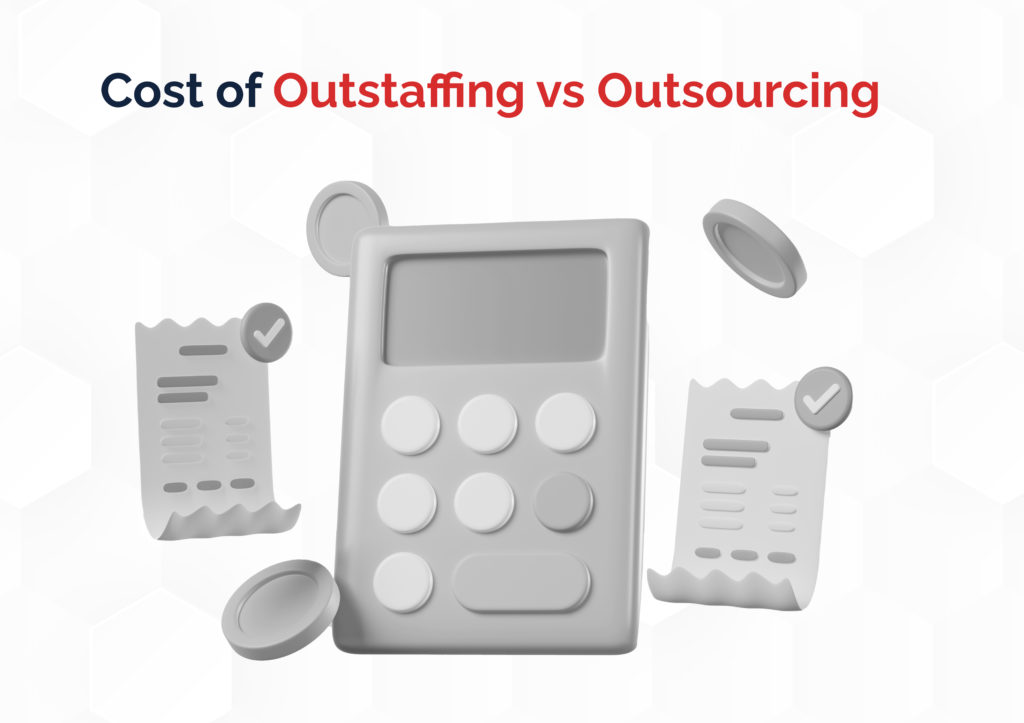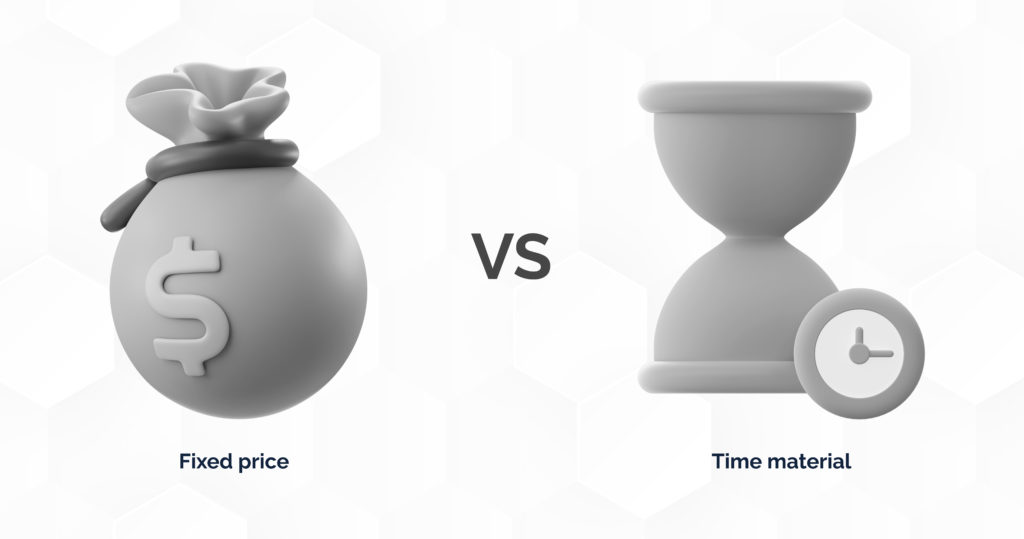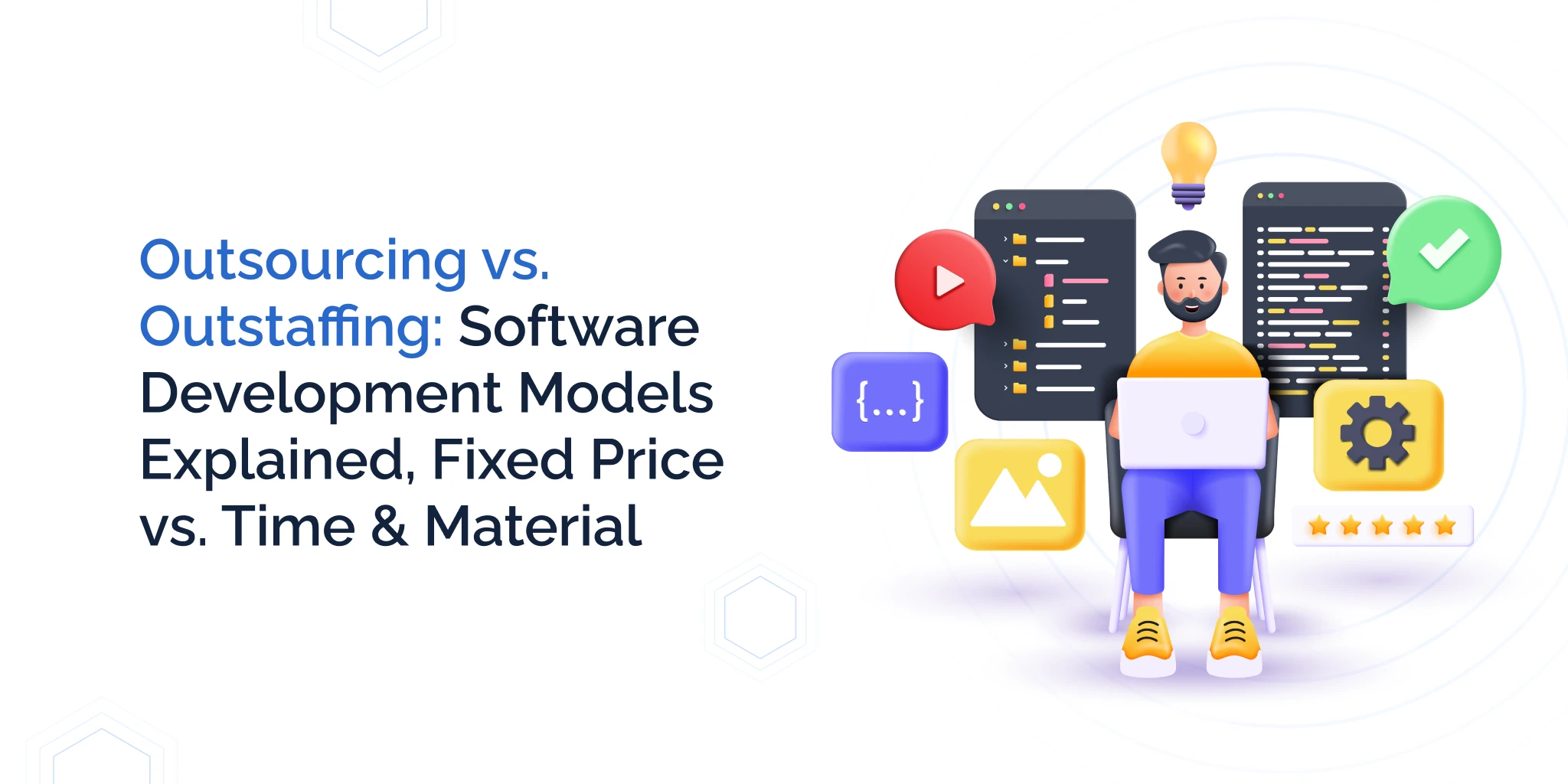The choice of your workforce often defines the quality of the work you receive.
The influence of outsourcing vs. outstaffing is usually very different. In this article, we provide the readers with extensive information on the topic to let them make a clear decision on the outsourcing model. In many cases, your success is likely to depend on how well the choices are presented.
Outsourcing vs Outstaffing: What is the Difference?
Let’s first look at the difference between the terms – outstaffing & outsourcing.
What is outsourcing?
Outsourcing tends to be a more well-known notion. It involves the process in which you give specific tasks to a contractor company completing them independently. The outsourcing company has a fully controlled and funded team, requiring no major management interventions on your part. Essentially, you ask an outsider business to complete your tasks fully. Intervention is possible in such cases. After all, the outsourcing company does not take instructions out of the thin air. Nonetheless, most development processes occur internally, with the partner offering insights after seeing some results of product creation.
The house example
You can find a proper example of outsourcing in the construction sector. Many people can’t build a house with their own hands. Instead, they can hire a firm to do all the relevant work for them. The construction team works according to your accepted plan but does so independently. You can come to the construction site from time to time and see if everything is alright, introducing some corrections. It’s possible to leave the whole process to the professionals in this case. The remote team will do everything alone, allowing you to enjoy the final result.
Pros of Outsourcing

Outsourcing has potential benefits that can help your firm save funds or manage time better. What are those? Let’s take a look:
- You don’t have to engage in management: regulating any form of a team is usually a challenging task. You often have to micromanage things that don’t directly relate to work, such as worker interactions. This approach would require you to invest in a rather large staff with many individuals who don’t have a direct relation to production. In the case of outsourcing, the partner company takes care of this as it has its team of managers to regulate all the key activities of the workers;
- You save funds: outsourcing teams often allow paying less than in the case of direct hiring. Many firms in this market work in diverging countries. As a result, you may choose from a wide variety of settings. For instance, some states have lower taxes, decreasing the overall scope of payment for the relevant workers. There’s also no need to invest in any office building or key equipment. Outsourcing teams genuinely take care of everything management-wise.
Cons of outsourcing
Here are some of the key issues you may want to consider:
- Your control over the key development processes isn’t strong: if you have many urgent directions for the key workers, the outsource vs. outstaff choice favors the latter option today. Outsourcing companies do everything on their own: therefore, interventions are only likely to bring about conflicts as the people in another team may have their own concept of the development process;
- Culture conflicts are possible: one of the problems behind any model you develop outside of the team is that the chosen control-related methods tend to be very divergent. What do we mean by that? Your company can have a more democratic control style, and another one can be more authoritarian. In such cases, the lack of understanding regarding certain management choices can genuinely undermine your ability to contact the partners in a positive manner.
Conclusion about outsourcing
Outsourcing is a great choice when you don’t want to microcontrol some project. It should usually touch upon work with clear instructions and technologies that aren’t difficult to replicate. The outstaffing model works when you trust the other party since you know it doesn’t have any trouble doing the key work well.
What is outstaffing?
And what about outstaffing? Many people find this term more complex. In reality, it’s rather simple. In case of outstaffing, you ask some outsourcing agency to provide you with one or several employees to join your team and follow your management. They remain on the payroll of the partners, but you have more or less full command over their tasks. This means they become an extension of your team. Usually, this type of work is remote, but it’s also possible to bring a person into your office as long as the agreement specifies this factor.
The house example
If we view outstaffing through the example of a house, it implies a clear knowledge of construction. You build the house with your friends and family, having a clear understanding of the key characteristics behind your project. However, you may feel the existing workforce isn’t enough to complete the project. An outstaffed builders team saves the day by joining your group and following your commands. They boost your capabilities to complete the project.
Pros of outstaffing
So, what is outstaffing going to give you? Let’s look at the key features:
- Cost reduction
An outstaffing company keeps the additional workers on its payroll. This means you only have to pay the firm but avoid the full management of the individuals in question;
- Full control
An outstaffing specialist works in your firm and does the things that you personally want. This means they won’t go against some of your wishes as easily as an outsourcing company;
- Hiring becomes easier
The outstaffing agencies are capable of choosing all the relevant specialists. This means you won’t have to spend a major amount of time on this task.
Cons of outstaffing
Still, some reasons for being skeptical exist. Here are some of them:
- You need to have a full-scale team in your business: when outstaffing you should understand that all the management must come from your firm. An outstaffing team requires your personal investments in control-related processes.
- Conflicts of culture are possible: many outstaffing companies can help you hire employees from abroad. The business process in one country can differ greatly from another. This disposition creates a ground for some serious conflicts within your teams. Certain individuals may find it difficult to understand the cultural characteristics exhibited by another nation.
Conclusion about outstaffing
In the end, the outstaffing model can help in many cases. When you need to exhibit strong control over your team and the overall business model, but there’s an emergency regarding the workforce, the framework should fit your needs perfectly. Outstaffing can help you quickly close the gaps in any team and enrich it with essential competencies crucial for long-term management.
Cost of Outstaffing vs Outsourcing

On average, there are no clear rules regarding the price of the methods. Outsourcing and outstaffing cover different scopes. They can be small or big. In some cases, outsourcing is cheaper because the partner company gives you access to all the key infrastructure. If you have your own frameworks or allow for work from home, outstaffing saves costs by giving much control over the workers. In short, claiming which approach is cheaper is difficult. You have to look at the overall processes employed in your firm to understand the relevant cost savings.
Fixed Price vs Time & Material Outsourcing and Outstaffing

A crucial aspect of any development project is focusing on the chosen payment model. In many cases, the relevant experience can differ. It’s crucial to know the key practices used in the development field to make correct choices.
Fixed Price
The fixed price model of outsourcing and outstaffing involves an agreement within which a partner company promises to produce a project with a clear price. You contact the partners and agree on the necessary payment through the overall analysis of its needs. The idea of this method is that you won’t pay more than agreed for the overall outsourcing/outstaffing project.
The house example
Let’s imagine you decide to build a house using the presented model. You hire a team of construction workers wholook at the key requirements and then offer you a final price that they consider to be sufficient for the completion of the project. According to the contract, you don’t have to pay for anything beyond the original sum. The builders have to complete everything according to the given plan. Obviously, this approach creates strong problems for all the relevant parties. If you don’t like something, changes may necessitate an additional contract on your part. The workers, if they fail at creating a good budget, would have to offer their company funds for the completion of the project. This way, there’s a high probability that one of the parties would be at a huge disadvantage, creating a perfect ground for conflicts between the relevant partners.
Time & material approach
The time and material approach can also be called a flexible one. In this case, the dedicated development team offers you an approximate description of the necessary costs. You, in turn, pay for the overall results and the materials/time involved in the development. This approach is generally safer for all the relevant teams. If you overestimate the cost of the project, it’s possible to deliver it at a lower price. At the same time, the cases when a project is more expensive should be easier to cover for the partner as they get full remuneration for the relevant tasks. In practice, this means that you can save large funds, and your partners may have fewer incentives to drop a project in a half-developed state if it proves to be overly complex.
The house example
If we use the house example, the model is easy to explain: the workers can provide you with interesting cases, showing their overall experience of building similar projects. This method allows insights into the overall building costs but youl pay for the end result. After all, the costs of the materials can change. The market is shifting all the time due to political and even health-related hazards. It’s impossible to predict the full price of the house in such a dynamic world. Daily control is crucial. Sometimes, the project can be cheaper. In other cases, you may have to pay extra. The only thing that can backfire includes trust: a team working via this method can provide false reports about costs. Thus, you have to be very careful about making the relevant choices. Software development outsourcing, regrettably, can have some predatory companies.
How to Find an Outstaffing or Outsourcing Company?
Finding an outstaffing or outsourcing company isn’t difficult today. Above all, you should pay attention to simple Internet searches. Many great companies strive to offer advertisements for their key services to potential customers. A good option is to look at the specialized hiring platforms dedicated to IT. Many individuals and even firms provide various clients an opportunity to get people for remote employment. More importantly, the Internet has many strong platforms for rating relevant firms. This means you can clearly deduce who offers the best options to the customers.
How Can Keenethics Help with Outstaffing or Outsourcing?

Our company is among the businesses with expertise in outsourcing and outstaffing tasks. We have a big team of specialists with a high level of expertise who are ready to assist with all of those relevant aims. More importantly, our contacts in the Ukrainian IT market are advanced and we can act as guides in hiring individuals within the country. When it comes to outsourcing, for instance, our company has a dedicated team that can quickly present you with strong solutions. We call it a task force. Many companies benefited from such an approach. Throughout the years, we’ve participated in a large number of outsourcing and outstaffing projects. Big success cases include projects such as Bookmaker, Ruuster, and Brainable.
To Wrap Up
To summarize, we hope this article has answered the two key questions: “What is outsourcing?” and “What is outstaffing?” In our opinion, both models make sense under certain scenarios. The former one works for projects where you’re sure about the long-term results and don’t have your own team of developers. The latter one perfectly functions when your company needs an influx of professionals to cover a particular unfilled position. If you need help with choosing the most efficient model for your company, feel free to address us. Keenethics specialists can provide you with an insight into all the key features of the models (for instance, time differences) and offer the most efficient short- and long-term solutions.

FAQ
How can we differentiate between outsourcing and outstaffing?
Outsourcing means you transfer all the work to some other company and it manages all aspects of its creation under your supervision. The process of outstaffing means you ask a firm to provide you with a worker who would then perform tasks under your management. In short, one case involves the development of a project in another company. As for the other one, some company gives workers to partner business for direct control.
How can we define outstaffing?
Outstaffing service offers you an opportunity to take a person from another company, place them under your management, and task the individual with an aim you have in mind.
How can we define outsourcing?
Let’s imagine you want to create an accounting program for your company but don’t have an IT department. You can outsource the work to a competent team, who would then perform all the relevant work within the confines of their organization.
Our professionals will gladly help you with your project! Learn more about why and how to hire a dedicated development team.












